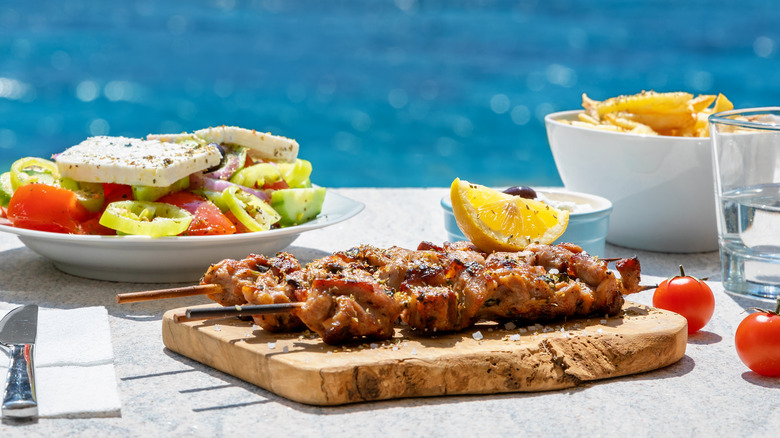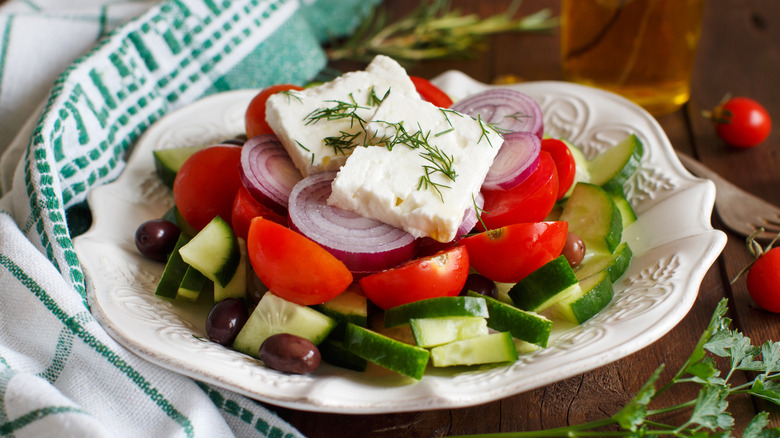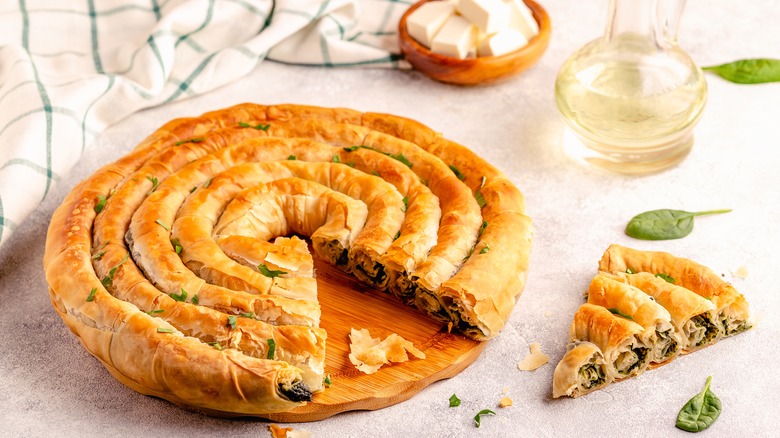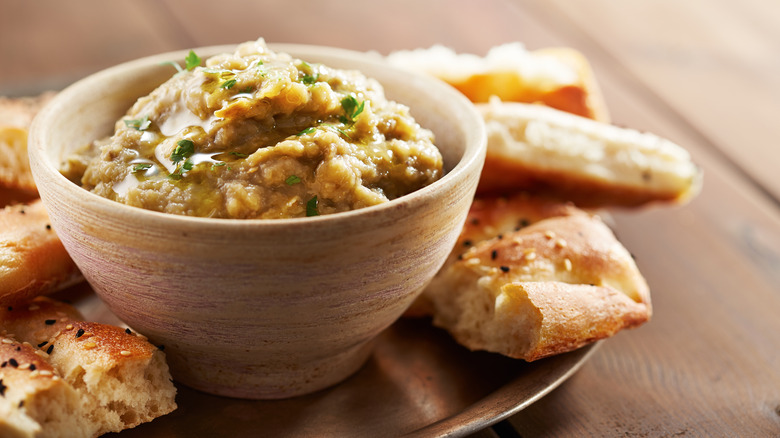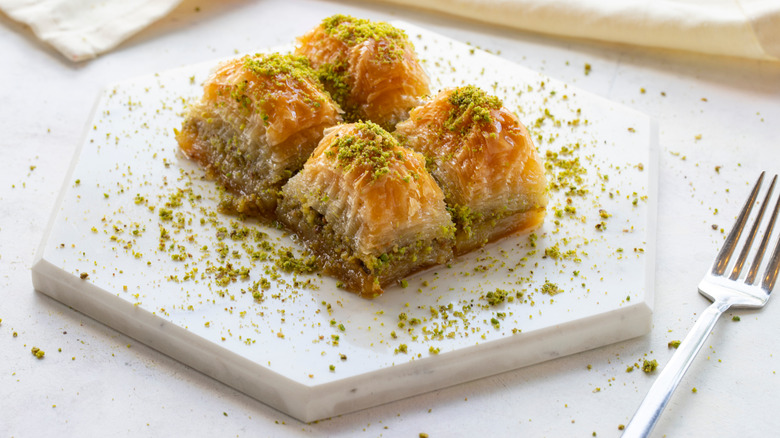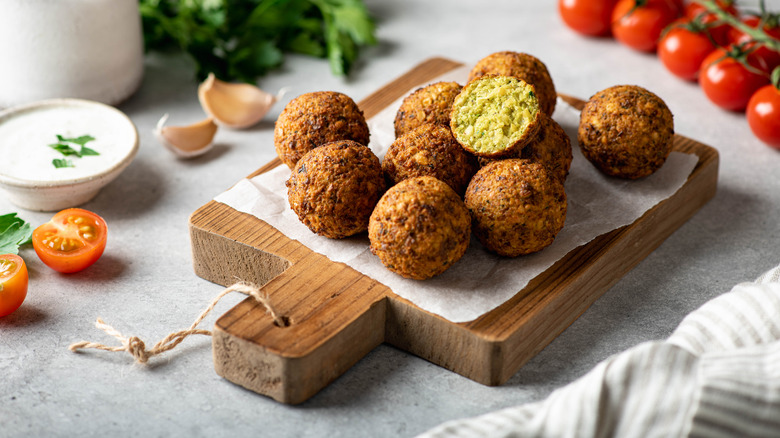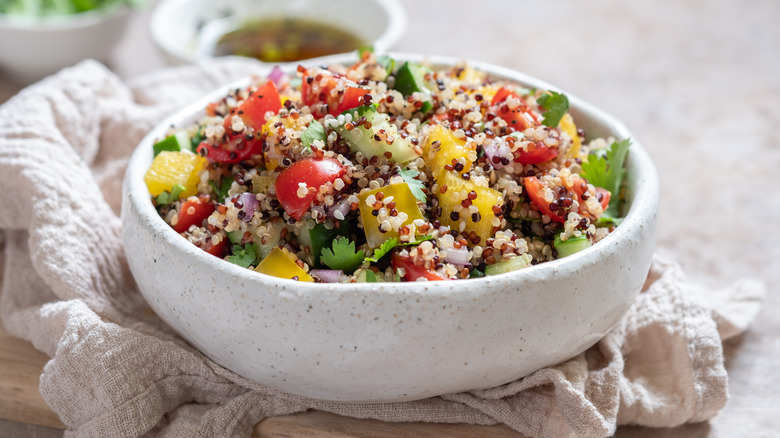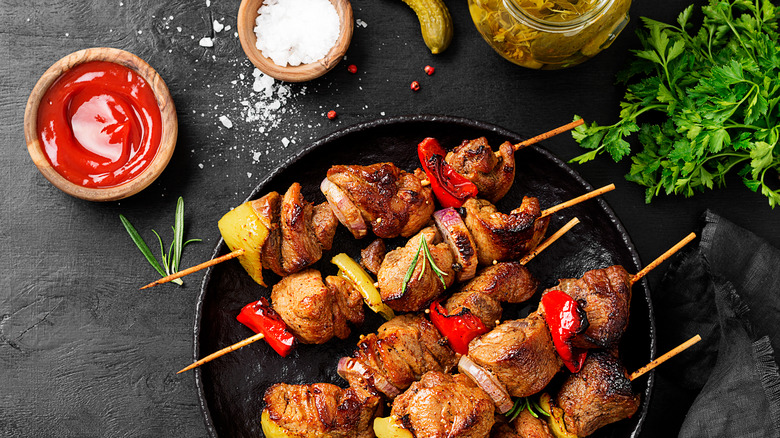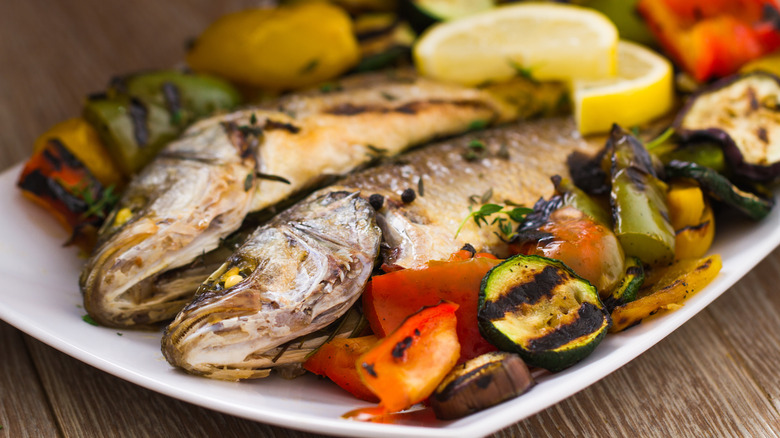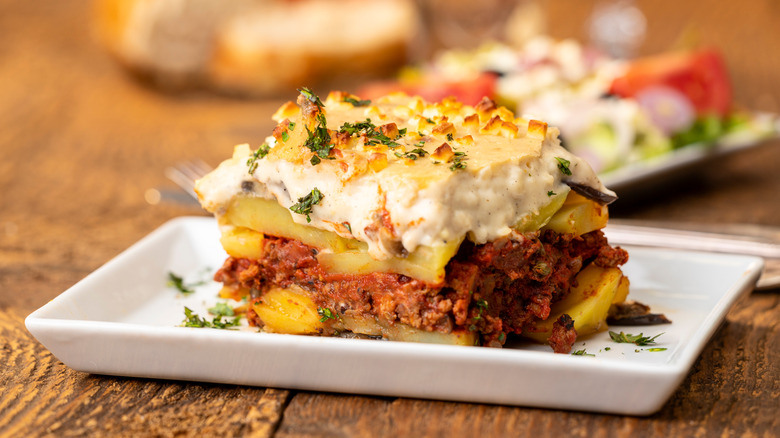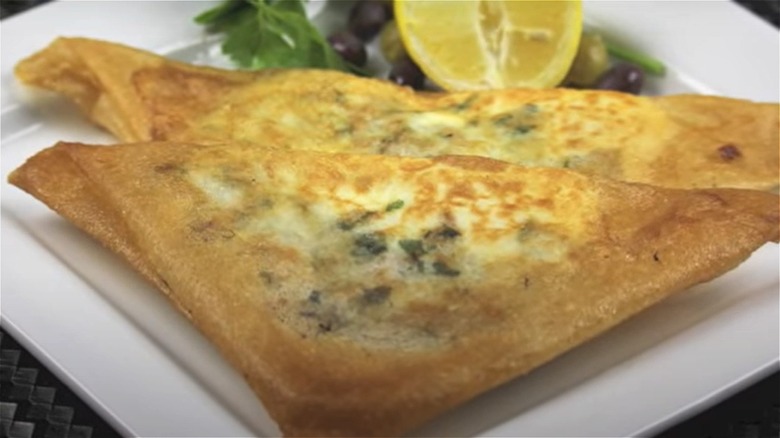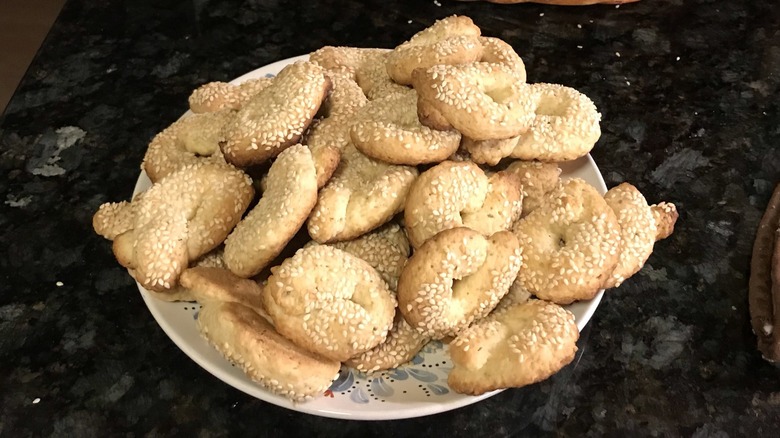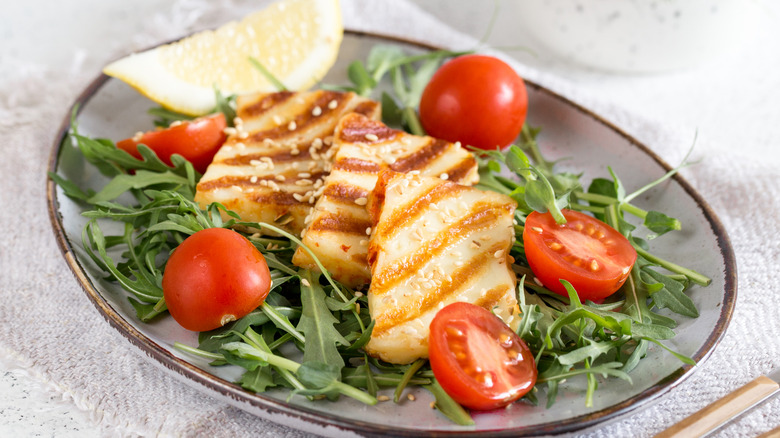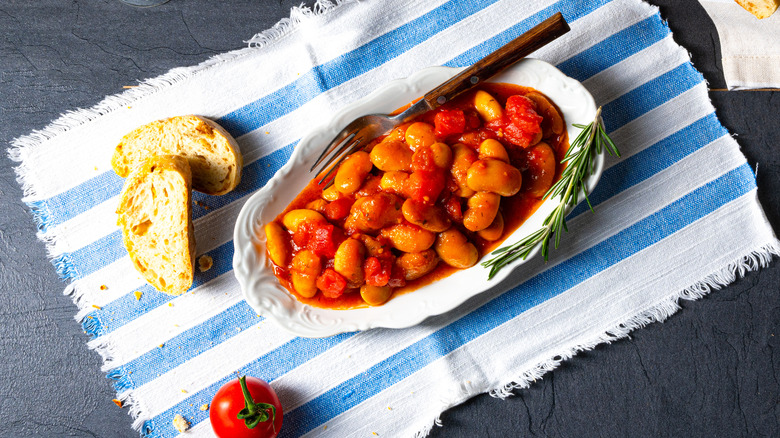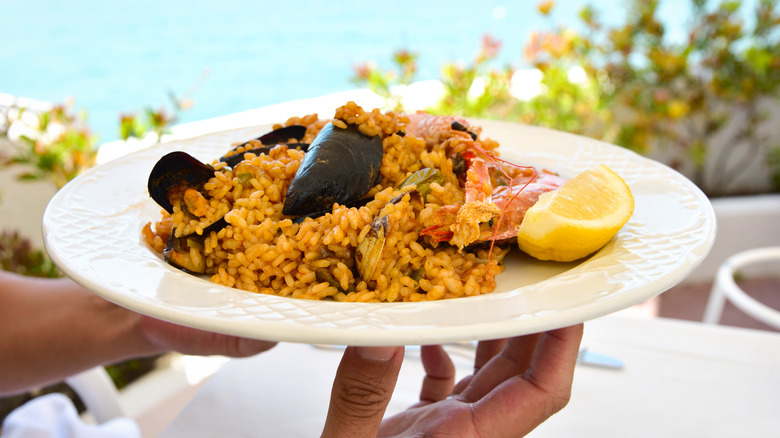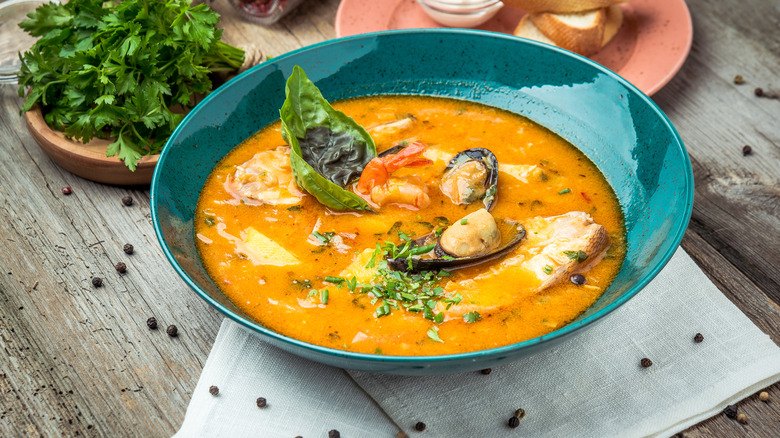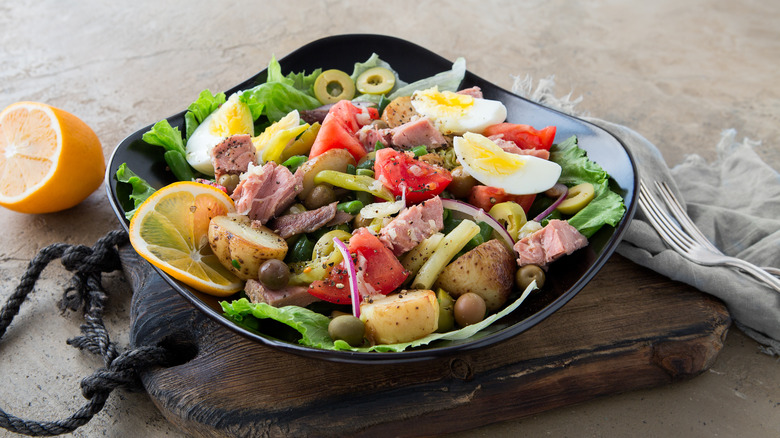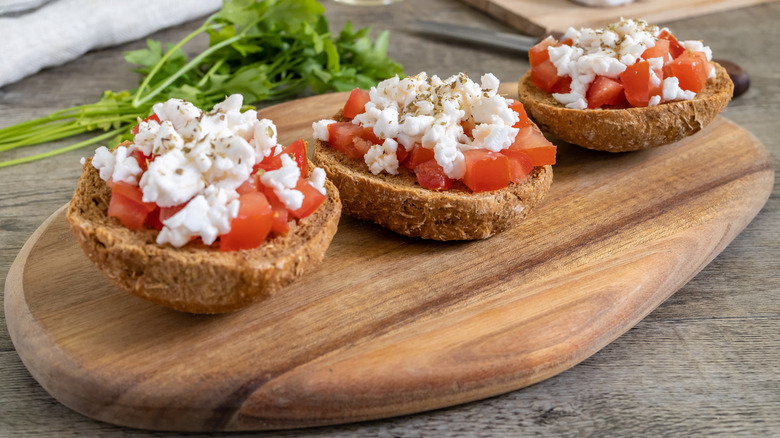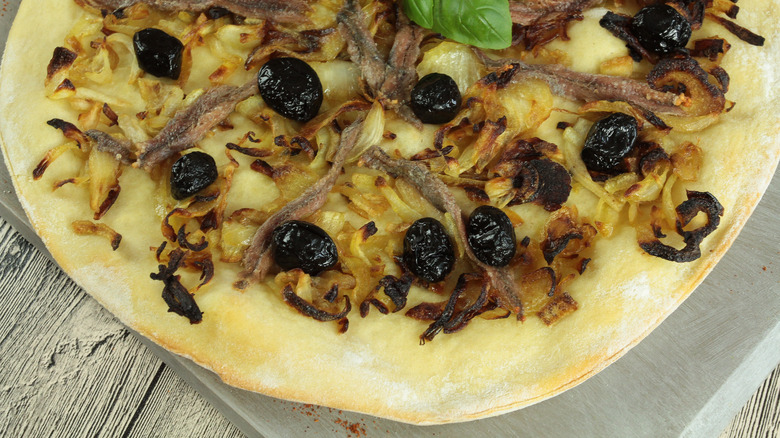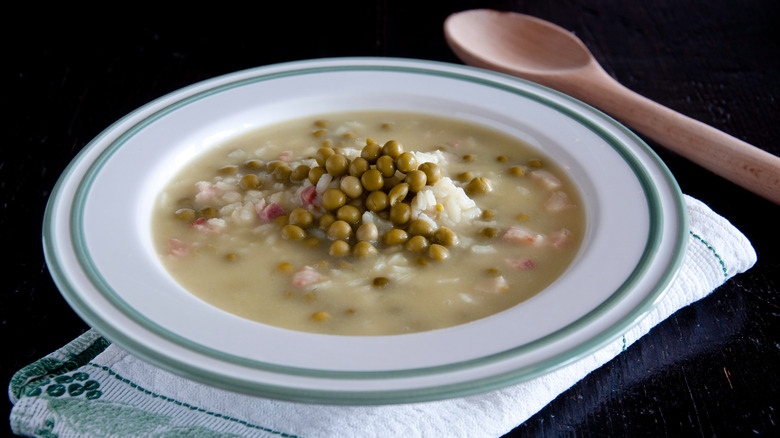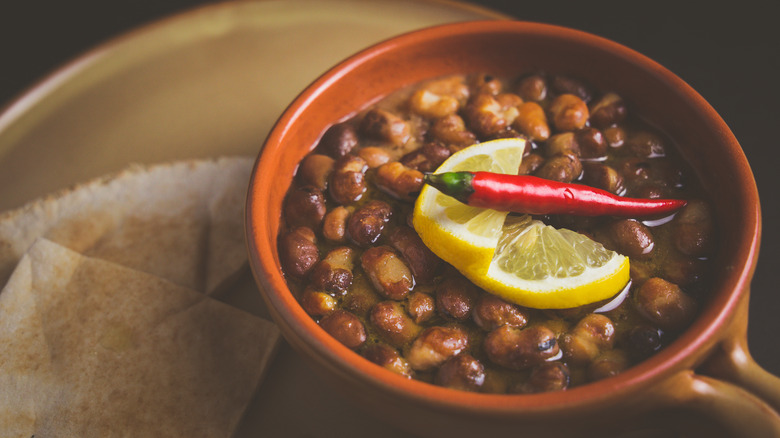Mediterranean Dishes You Need To Try At Least Once
After surviving 2020 and 2021, everybody deserves a holiday — a Mediterranean holiday. Just imagine, swimming in the shimmering waters of Sicily and Sardinia, driving across the coastline of the French Riviera, or enjoying a siesta in Barcelona. Don't those activities sound like the most relaxing things one could possibly do?
However, as we all know too well, it's not so easy to get from here to the Mediterranean on a whim. Most of us will continue to toil away without ever getting the chance to whiff Portugal's coastal sea breeze or relax under the Turkish afternoon sun. Yet, while this may be the case, there's a good reason not to get too down about it. And this is because we can always bring the Mediterranean to us: by visiting a restaurant or local bakery or even by giving a recipe or two a try in our very own kitchens.
So, with that in mind, here are 20 Mediterranean dishes we think you should try — at least once. All of these dishes are scrumptious, authentic, and might even transport you to this beautiful place for a moment.
Greek Salad
If you were asked to envision a salad, some of you might immediately jump to thinking about a pile of sad lettuce and some soggy croutons. But while these sorts of salads do exist, a classic Greek salad isn't one of them. This dish, otherwise known as a horiátiki salata (via Mediterranean Living), features sweet tomatoes, crisp cucumbers, olives, bell peppers, and a slab of feta on top. All of these fresh and classic ingredients combine to create a salad that's both light and succulent.
According to Greek culture website Greek Is, the Greek salad dates back to around the 1960s or 1970s by Athenian tavern owners, who made these feta-heavy salads as a way of circumventing the Greek government's price limits on traditional salads that consisted of just tomatoes, cucumbers, peppers, and onions. Because these new salads had great big bits of feta on them, the taverns in Athens could charge whatever they wanted for the dishes. And fortunately for them, this updated recipe was such a hit that it then went on to be an absolute classic.
Spanakopita
Spanakopita, or spinach pie, is one of those dishes that proves you don't have to over-complicate a food in order for it to be great. It's made from spinach, feta, and phyllo pastry, with additional ingredients like Parmesan cheese, eggs, and onions that vary by recipe. Per The New York Times, it's always best to use fresh spinach when making spanakopita, though frozen spinach will work as well.
Now, the most tricky part of cooking this incredible pie yourself would be the phyllo pastry. This is because the delicate crust is quite difficult for cooks (of any level) to make at home. Moreover, making the pastry dough from scratch is a time-consuming process, as My Greek Dish explains. But if this component of a spanakopita is a deal-breaker for you, using store-bought phyllo is perfectly fine. In fact, most cooks today will probably use a box of phyllo, similar to readymade pasta. Of course, you could also check around your neighborhood bakeries to see if any of them make the Mediterranean pastry to go.
Baba Ganoush
Baba ganoush has a contentious history. The term baba ganoush means "spoiled old daddy," and per one story, the eggplant dip was originally made by a doting daughter for her toothless aging father (via the New York Public Library). However, according to food writer Gil Marks, the Lebanese starter may have been named after the eggplant in it, as eggplants are colloquially known as "big daddies." Nevertheless, despite the fact that baba ganoush's true origins are debatable, this approximately 800-year-old dip is one you'll want to learn about yourself if you're ever looking for a new addictive spread, according to Cooks Without Borders.
But what exactly makes baba ganoush so addictive once you've tried it? Let's start with the aubergine, or eggplant, which has to be either grilled or cooked until it has a smoky aroma, a soft texture, and a crispy skin. This eggplant is then combined with ingredients like tahini, garlic, and lemon to create a complex, delectable Mediterranean dip that pairs well with "fish, grilled meat and fresh thread bread" (via Levantine Recipes).
Baklava
A lot of different cultures have claimed baklava as their own. In fact, as the Greek Reporter states, the pastry's origin has been a source of tension between Greece and Turkey for centuries. Not to mention the Middle Eastern countries that also lay claim to the delicacy's birth. This said, as the "Baklava Conflict" is one better left to the food historians, we'll simply note that baklava is indeed a beloved dessert — including in Mediterranean homes — and move on as to why.
So, what makes baklava brilliant? According to the Rakija Lounge, it's because baklava manages to strike a balance of taste and texture, a crunchy dessert that is "quite sweet" but can be a perfect complement to a savory meal or enjoyed with a cup of hot tea or coffee. It's a delicate pastry, made from layers of phyllo dough and nuts coated with a mix of sugar and cinnamon (for the crunch), cooked in the oven until golden brown, after which honey syrup is poured over the top.
Falafel
Per The Guardian, falafel may just be the best vegetarian fast-food ever: a deep-fried fritter (though you can bake them, too) that's crunchy on the outside, fluffy on the inside, and the perfect size to enjoy on the go.
Making falafel at home isn't too difficult either. One tip to remember, though, is to use fresh pulses. According to Kitchen Stories, using canned pulses (like chickpeas) can lead to mushy falafel centers. Instead, you'll want to opt for dried versions of your lentil, bean, or pea, and let the pulses soak overnight to retain their texture for fluffy results.
Falafel shops and stands are literally everywhere, from seaside towns in the Mediterranean to college towns across the United States. Hummus Bowls & Wraps notes that falafels made it to the U.S. in the 20th century, but that the fritter's origin dates back centuries, most likely originating in ancient Egypt — though, like baklava, there is a contentious debate over which country can truly claim falafel as their own (via History Today).
Tabbouleh
According to food writer Corby Kummer, tabbouleh originated in the mountains between Lebanon and Syria, and per Culture Trip, there's nothing more Lebanese than the dish. The cold salad is a standard part of the country's version of "meze" (or mezze, a selection of appetizers) and is a staple in its national diet (National Tabbouleh Day is celebrated on the first Saturday of July). Traditionally made with cucumbers, tomatoes, parsley, mint, lemons, and wheat, this Mediterranean salad is a menu item commonly found at falafel shops and stands.
When making tabbouleh, it's important to use the right type of wheat, and that wheat would be the 4,000-year-old bulgur wheat. According to The Spruce Eats, bulgur could be considered the "world's first convenience food." The whole grain wheat tastes nutty once cooked and is chewy in texture, perfect for tabbouleh. Also, it's advisable when making tabbouleh to use medium-coarse or extra-coarse bulgur as these types of bulgur wheat are less likely to get soggy (via Family Style Food).
Shish Kebabs
Shish kebabs are literally skewers with cooked pieces of meat and veggies. Their food origin traces back to medieval times when Turkish soldiers were said to grill meat on their swords, per The Spruce Eats; though, as the outlet notes, there is evidence of kebabs dating back even further than that: to ancient Greece and the time of Homer. While versions of kebabs have spread all over the world — far beyond the Mediterranean — they remain a signature dish of Turkey.
If you want to try your hand at making some shish kebabs yourself, don't hesitate: The dish is simple to prepare and cook. The key is the marinade, which will caramelize on the grill as the kebabs are near done. And while shish kebabs may have been originally made with meat, there is absolutely no rule that says this is how you need to make them yourself. Vegans and vegetarians can make their own veggie versions, and you can also try a "shish meyve" using seasonal picks like peaches, apples, or pears (per Clean State Cleanse).
Branzino
According to the SeafoodSource, the popular Mediterranean white fish branzino goes by a number of different names. Some call it the European sea bass, whilst others call it Greek sea bass. Germans, meanwhile, call branzino the terrifying-sounding wolfsbarsch ("wolf of the sea"). This nickname has more to do with branzino's ravenous appetite (via On the Gas) rather than its own taste, though. Indeed, fortunately, the branzino doesn't taste anything like wolves and instead has a pleasantly sweet and light flavor profile, making it the ideal star of many a Mediterranean dish.
There are plenty of different ways to prepare branzino, but of note, it is a fish that's meant to be cooked whole, like snapper or bass, per The New York Times. As chef Steve Corry explained to Food & Wine, (which recommends roasting branzino and serving it with a caper butter sauce), "It's almost impossible to end up with dry, overcooked fish when cooking it whole. The bones protect against extreme heat, plus they add flavor and moisture."
Moussaka
As Cooks Without Borders explains, a piece of moussaka can be completely different depending on what part of the world you're in. In Bulgaria, for example, moussaka could be a rice dish, while in Romania, it's a meal with noodles. For our purposes, we'll focus on the Greek version of moussaka — a Mediterranean classic made from layers of meat and eggplant, topped off with the very French béchamel sauce.
Though moussaka's origin story remains a mystery, it certainly has come to be known as a staple of Greek cuisine. In fact, Culture Trip states that moussaka is perhaps the best known of all Greek foods (along with gyros and souvlaki). Its modern version is thanks to the French-trained Greek chef and gastronomist Nikolaos Tselementes, who made it his mission to westernize and Europeanize Greece's cuisine, which he felt had gotten away from its culinary roots while under Ottoman rule.
Per Cooks Without Borders, the choice of a béchamel sauce topping reflects not only Tselementes' French training but also his belief that French cooking owed its own roots to ancient Greece.
Brik
Deep frying food is a human discovery that's up there with inventing the airplane or working out how the dinosaurs got wiped out, and we can thank the cooking method for giving us the Tunisian pastry brik — although healthier versions can also be baked, according to Taste Atlas. Crunchy in texture, the pocket pastry can contain a variety of fillings of choice, but many a brik will fold in a cracked egg, which will partially cook, then flow out runny once the pastry is broken.
Brik can be found across Tunisia and its Mediterranean coastline. Its origins date back centuries, but given that its name is of Turkish origin and Tunisia was under the Ottoman Empire from the 16th century to the 19th century, it's unclear when brik was invented, per Roads & Kingdoms.
As for the filling, it really can be anything you like. But, as Taste Atlas notes, the most common in Tunisia is tuna-based and seasoned with North African spices.
Ottijiet
It's a fact that there aren't enough dinnertime cookies. Sure, there are cookies for a midnight snack and to pair with your morning tea, but there are some times when these types of biscuits just aren't what you're after. Fortunately for us looking for a heartier cookie, there exists the ottijiet. These sweets are a favorite of cookbook author Meike Peters, who discovered ottijiet while holidaying in the Mediterranean. Ottijiets are a snack known for offering an amazing orangey, lemony, aniseed-like taste.
One of the most interesting things about these cookies is that they're shaped like little eights. This is because ottijiet is somewhat derived from the Italian word for the number eight, otto; ottijiet, Peters explains, is the plural of "otta."
The UK magazine Delicious likens ottijiet to shortbread biscuits, and as Apron & Whisk notes, the hearty composition of ottijiet makes them perfect for dunking (at teatime).
Halloumi Salads
If you're a cheese stan that hasn't tried halloumi yet, then you have to go get some immediately. Halloumi is delightfully chewy, firm, and salty once it's been fried up. It's perfect on bread, in burgers, and by its very lonesome. This cheese also works incredibly well in salads. Its bright, briny profile pairs well with the sweetness of some fresh tomatoes or the crunch of a nice bit of lettuce.
Halloumi was first created in Cyprus, but Cyprus' version can almost be a completely different cheese in this country. This is because Cyprus halloumi is typically made from sheep milk, goat milk, and a bit of cow milk, while other versions are predominantly made with cow milk. The difference between the two is huge, with the traditional Cyprus halloumi having a softer texture more akin to bocconcini or mozzarella. Moreover, people in Cyprus like to eat their halloumi fresh and paired with ripened grapes, according to Broadsheet.
Gigantes Plaki
A lot of Mediterranean dishes are light and summery, so let's change the pace up a bit. Gigantes plakis is a classic Greek baked bean dish. This dish is known for starring fasolia beans, a giant type of bean similar to lima beans or elephant beans. The giant beans are cooked with tomatoes, garlic, onion, and a ton of other veggies to make an extremely hearty meal (via Kopiaste).
The classic way of making gigantes plaki is inside a fired clay or earthenware casserole pot. These traditional pots are called gastras, according to Travel Guides by Dana Facaros & Michael Pauls, and they are likened to round Dutch ovens. Nevertheless, if for obvious reasons, you don't have a gastra in your kitchen, you can cook your gigantes plaki in any old casserole dish or baking tin or Dutch oven.
What's great about this meal is that the whole thing is vegan. So, if you want to share some good vibes with a friend that prescribes to a vegan lifestyle, then this dish might be worth busting out the next time you're both catching up.
Paella
There's no denying it, paella is an iconic food. In fact, in 2016, it got its own emoji when it was added to Unicode 9.0. What's more, the importance of this Mediterranean dish was highlighted when Apple got its first version wrong, as the emoji was meant to reflect the dish's Valencia roots, but was missing some key ingredients. Thankfully, this was fixed by Apple a few months after its debut, and we can now all use the paella emoji in our texts, per Emojipedia.
While the Valencia version is very specific, paellas can be made with a lot of different ingredients. It usually consists of rice, aromatic veggies, a stock, a type of meat, and some beans, according to MasterClass. You can make it your own.
This said, as Spain Secrets notes, there are five main types of paella: Paella Valenciana (made with chicken and pork, and what Apple changed its emoji to), Paella Mixta, Paella de Marisco (a seafood version), Paella Vegetariana, and Paella Negra (made with squid ink and black in color).
Bouillabaisse
If you thought that paella was on the technical side of things, then wait until you learn about what's in a bouillabaisse. According to Serious Eats, the bouillabaisse that many American restaurant-goers are most familiar with, which often features a lot of shellfish — specifically lobster — is quite different from the Provençal French version: a fish soup featuring saffron, fennel, and a touch of orange zest.
As Culture Trip explains, bouillabaisse is from Marseille, a local delicacy first made by fishermen who needed a way to make use of the bony rockfish they were unable to sell. Thus, authentic bouillabaisse (a word that combines the Provençal words "to boil" and "to lower") is simply a soup made of fish, first boiled and then simmered at a low heat until it's perfectly done. Some versions can take up to two days to make, though others will only take a few hours or so.
Salade Niçoise
The French dish "salade niçoise" has an incredibly straightforward name. When you translate these two words into English, they work in unison to mean "a salad that comes from the French city of Nice." This aptly named dish was originally made with just anchovies, tomatoes, and olive oil, according to the Times Malta.
If that all sounds a little too simple for your salad taste buds, then you might be open to some of the ways chefs have spruced up the Mediterranean classic, working in ingredients like potatoes, tuna, green beans, and eggs. However, by adding in these other flavors, does the end result even qualify as a true salade niçoise?
As the Times Malta reported, there's at least one group who would agree that it's no longer "a salad that comes from the French city of Nice." Cercle de la Capelina d'Or are traditionalists who feel a salad niçoise cannot veer too far off the original Nice recipe. The group's president Renee Graglia recalled being served an updated version, "I was served Niçoise salad with mayonnaise. I was horrified!"
Dako
Sometimes you just want a lunch that's a bit more classy than a standard peanut butter sandwich. And if you ever find yourself feeling this way, then eating a dako might just sate your curious appetite. According to The Spruce Eats, dako is a light, easy meal that comes from the island Crete. This dish's main flavors consist of grated tomato, crumbled feta, olive oil, and black pepper. All of these ingredients are spread on top of a slice of bread.
As for the bread, it's specifically a rusk: a bread that has been twice-baked into a hard and dry loaf or biscuit. The result is a bread that's substantial enough to withstand a dako's grated tomato without becoming soggy. Think of the sourdough bread bowls used for chowder in San Francisco and elsewhere; it's the same idea. And in fact, as The Spruce Eats notes, these barley rusks from Crete often contain sourdough, which helps to prolong their shelf life.
Pissaladière
If you believe that the Italians are the only ones who bake amazing toppings on a flat, bready base, then think again — because we're about to discuss the pissaladière, which is sometimes thought to be France's answer to pizza.
The similarities between these two dishes are quite interesting, as pissaladière features some classic pizza toppings, such as olives and anchovies. Furthermore, it also has a base that resembles a pizza base, according to The Frugal Flexitarian. However, that's where the similarities end. For one, a pissaladière doesn't feature tomato sauce nor is it covered in cheese. Moreover, the culinary world can't seem to agree on whether this dish should use a pizza-style or a shortcrust pastry dough; Serious Eats says you can use either.
The pissaladière — perhaps best described as a tart, and therefore, a pastry — uses sweet, caramelized onions that contrast perfectly against the saltiness of its olives and anchovies. The crunch of the crust complements the softness of the dish's interior.
Risi e Bisi
The idea of sitting down to eat a soup made out of rice and peas might be hard for your inner 5-year-old to fathom. But just such a creamy dish is enjoyed in Venice every spring, according to The Guardian. It's called risi e bisi, which simply means "rice and peas."
As the outlet explains, making this meal is more complicated than putting some frozen peas and reheated rice into a bowl. First off, you need to use fresh, small, tender peas in your risi e bisi, to create the sweetness that is the signature of this dish. These peas are then combined with a starchy rice called Vialone Nano and some high-quality stock.
As Italian Storytellers explains, risi e bisi is a hearty dish with a consistency that falls somewhere between a soup and a risotto, and in fact, there doesn't seem to be a local consensus on which of the two menu categories the dish is best-suited for.
Ful Medames
Ful medames, a dish with origins tied to Ancient Egypt, is actually the national dish of Sudan (per International Cuisine). Made with slow-cooked fava beans, the dish is popular not only in Egypt and Sudan, however; ful medames is part of cuisines in other parts of the region as well, including Lebanon, Syria, and Jordan, according to The Washington Post.
Because ful medames is so widespread along Mediterranean coastlines, though, recipes for the dish vary, depending on where it's made. Common to all versions, however, is that ful medames is a hearty meal, one enjoyed for breakfast to give you energy for the day ahead. Ful medames is most often served with pita bread, which makes for a handy tool for scooping up the last of the fava beans.
On that score, Ethiopia is an exception, per The Spruce Eats, as the country's version replaces the pita bread with injera (a fermented flatbread) instead.
